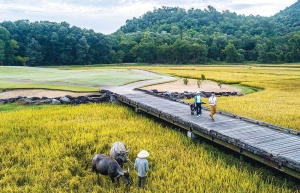Golf tourism still to be unwrapped
The Hanoi Golf Cultural Exchange Week, which took place on October 17-23, provided a model that could be replicated across many golfing destinations across the country. About 360 international golfers participated, playing at world-class clubs owned by BRG Group through the event, and had the opportunity to visit famous tourist attractions around Hanoi and neighbouring localities.
 |
| Golf tourism still to be unwrapped |
Anthony Lim, a golfer from Singapore said, “Vietnam has some beautiful courses. International golfers will know more about Vietnamese courses if marketing activities are carried out strongly. The important thing lies in your marketing and brand development policy.”
Hanoi is prioritising promoting golf and leisure tourism along with local culture and cuisine. It aims to take advantage of golf tourists, who traditionally spend much more than regular tourists on average. The city recently overtook such famous Asian tourism hubs as Bangkok, Beijing, Seoul, and Kyoto to become “Asia’s Leading City Break Destination 2022” at the World Travel Awards.
Dang Huong Giang, director of Hanoi’s Department of Tourism said, “Golf tourism will be one of the important tourism products of Hanoi in the future. It will help Hanoi attract international tourists, especially those with high spending levels from the Korean, Japanese, American, or European markets.”
According to Pham Thanh Tri, vice chairman of the Vietnam Golf Tourism Association (VIGTA), besides world-class courses, Vietnam also has a unique culture that golfers can explore, especially those from Northeast Asia. “Out of 10 South Koreans who come to Vietnam, eight go to a course at least once,” he said.
However, the number of international golfers heading here is only a small part of the overall amount of foreign travellers visiting the country. One reason that may hinder the attraction of Vietnamese golf is the higher costs for related tours compared to other countries like Thailand or Malaysia. VIGTA’s Tri said that the cost of golf tourism products in Vietnam was higher than elsewhere because the sport is still subject to high tax rates, including 20 per cent excise tax and 10 per cent VAT.
Meanwhile, Thailand and Malaysia have long-established package tours associated with golf tourism thanks to encouraging policies from their governments and close-knit cooperation between clubs and related service providers such as hotels, restaurants, and travel agencies.
Before 2020, Thailand, for example, has more than 300 world-class courses offering affordable prices, and 9 per cent of its total 35 million international travellers come for golf. In Vietnam, the rate is less than 1 per cent.
Statistics from the Vietnam Golf Tourism Association show that before the outbreak of the pandemic, Vietnam welcomed 1.5 million international golfers out of a total of 18 million international travellers in 2019, with a revenue of $195 million. The total industry was valued at $32.8 billion.
Another reason making the sport less attractive here is the shortage of convenient connections between luxury accommodations, restaurants, and courses. “Even the connection between resorts and golf courses in a complex is uncoordinated. Sometimes we can book a flight, but cannot book a room and vice versa though they are located in one complex,” said a representative from Global Travel.
A Toan Cau Travel representative said that the number of its VIP guests booking golf resort packages had increased by 40 per cent this year. “On average, about 20-30 guests are asking about the package per day. They mainly come from South Korea and Germany and wish to play golf during business trips or holidays,” he said.
Vietnam has up to 100 golf courses in operation, of which 32 are of national 5-star standard combined with luxury resorts. The number of courses is expected to increase to 200 by 2025, with the total number of players reaching about 300,000 people, including Vietnamese and foreigners living here, according to the Vietnam National Administration of Tourism.
| Nguyen Trung Khanh-General director Vietnam National Administration of Tourism The resort market has begun to enter the saturation phase. To take the lead, Vietnam needs a unique type of tourism, and golf is the answer to this. Golf tourism has been valued at $20 billion, with over 66 million tourists playing golf at about 32,000 courses worldwide. Projects attract the participation of many investors, create many jobs, and are more competitive, offsetting seasonality compared to other traditional forms of tourism. Many countries worldwide have paid great attention to golf planning in their tourism development strategy, and Vietnam is no exception. By 2030, the development of infrastructure and golf tourism products will be a key part of Vietnam’s tourism industry. This will not only help diversify products and improve tourism’s competitiveness, but also help the industry attract visitors with high net worth for long stays. We are promoting golf tourism to domestic and foreign tourists, encouraging links in golf tourism development towards the organisation of professional tournaments, and improving the quality of facilities such as resorts, restaurants, and healthcare services. We encourage cooperation with travel businesses to connect golf courses, tourist destinations, and participate in major international fairs in target markets to accelerate the recovery of the tourism industry and make golf tourism stronger. Eric Lynge-Special advisor for Asia Sports Marketing Surveys Vietnam has a young golf tourism industry. Only 28 per cent of golf courses in Vietnam have been in operation for 10-20 years, nearly one-third has been in operation for 5-10 years, and the remainder less than 5 years. During off-season, 18-hole golf courses in Vietnam will receive an average of 160 guests on weekdays and 250 guests on weekends. A survey of golf courses participating in the Vietnam Golf & Leisure Awards 2022 conducted by Sports Marketing Surveys shows that before the pandemic, one-quarter of courses in Vietnam had foreign guests comprising more than half of the guest total. The vast majority allow guests to book through tour agencies, and 91 per cent can receive bookings directly from golfers. Golf courses need support from tour operators to promote business activities, and marketing factors will determine the destination for domestic and foreign golfers, in addition to other important factors such as climate, golf course quality, accommodation, and value both on and off the course. Vietnam has great potential to become stronger in the golf tourism market. The country can enter the top 5-10 golfing destinations in the world and number one in Asia in the coming years with the appropriate research and promotion strategies. |
 | Vietnam – an emerging top destination for golf tourism Thanh Mai explores how Vietnam can become a new frontier for golf and the opportunities and challenges that exist in promoting the country’s golf tourism to its full potential. |
 | Bright prospects for Vietnam’s golf tourism BRG Group chairwoman Nguyen Thi Nga, honoured in the list of Asia’s most powerful people in golf at the annual Asia Pacific Golf Summit (APGS) in 2018, plays an important role in promoting the development of golf tourism with an optimistic and forward-thinking view of the tourism industry as a whole. |
 | 50-million USD beach golf course to be built in Da Nang The People’s Committee of the central coastal city of Da Nang has approved plans for a 36-hole golf course by property developer VinaCapital Group. |
 | Golf set to drive tourism recovery Having been voted Asia’s top golfing destination for five consecutive years, Vietnam possesses a lot of potential for the development of golf tourism. |
What the stars mean:
★ Poor ★ ★ Promising ★★★ Good ★★★★ Very good ★★★★★ Exceptional
 Tag:
Tag:
Related Contents
Latest News
More News
- The destinations powering Vietnam’s festive season travel demand (December 04, 2025 | 18:33)
- Vietnam named among the world’s most exciting winter destinations (December 04, 2025 | 15:10)
- Phu Tho emerges as northern Vietnam’s new tourism hub (December 01, 2025 | 17:00)
- Vietjet completes Airbus A320/A321 updates ahead of deadline (December 01, 2025 | 09:49)
- Vietjet resumes Con Dao flights from early December (November 28, 2025 | 15:24)
- Free tickets, Lunar New Year promotions on offer at Vietjet Mega Livestream (November 26, 2025 | 15:32)
- Scandinavian Airlines and Vietnam Airlines broaden agreement with new routes (November 25, 2025 | 17:04)
- Halong Cruise Port welcomes over 3,100 international visitors (November 12, 2025 | 18:06)
- Vietnam.travel climbs to second place in Southeast Asia website rankings (November 12, 2025 | 18:01)
- Cat Ba named among Southeast Asia’s top island adventures (November 11, 2025 | 18:09)























 Mobile Version
Mobile Version